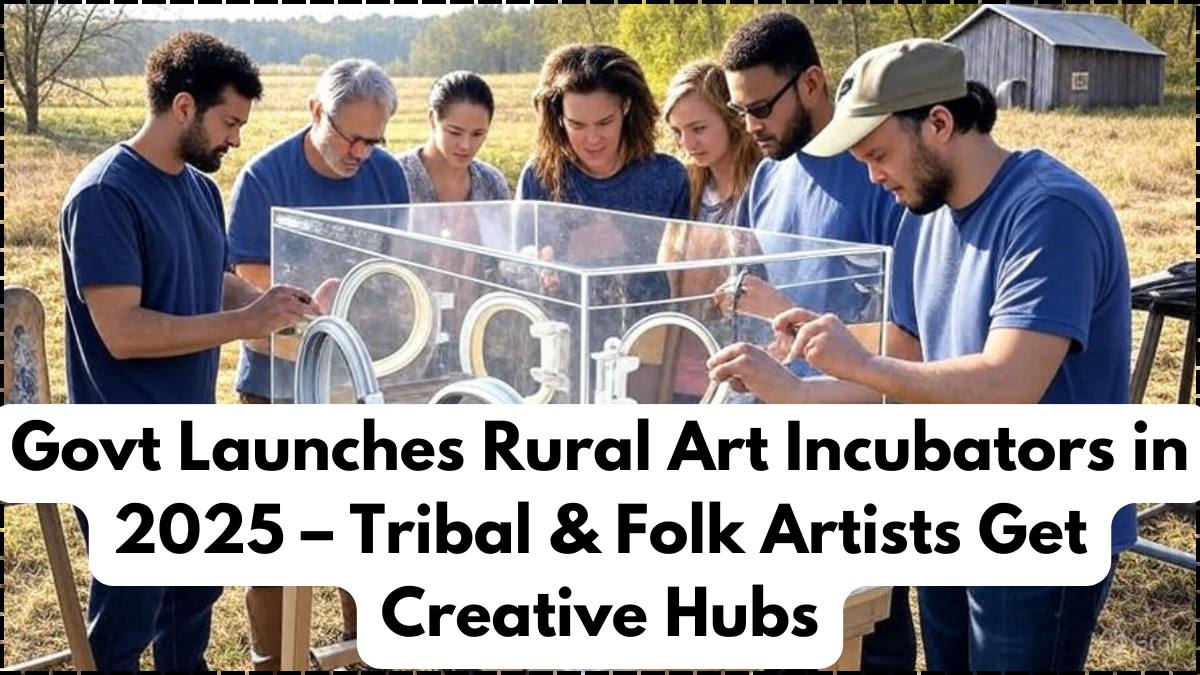India’s traditional art forms are getting a modern boost in 2025, as the central government rolls out a nationwide initiative to establish rural art incubators 2025 India. These creative hubs are designed to support tribal, folk, and village-based artists by offering training, workspace, raw materials, marketing access, and digital platforms for selling their art.
The program is part of a broader mission to revive dying art forms, economically empower artisan communities, and bring rural creators into national and global conversations. More than just funding, this is long-term govt support for folk artists, with structured programs, expert mentorship, and direct market linkage through online platforms and exhibitions.
With over 150 incubators planned for 2025, these centers are breathing life into centuries-old crafts while generating new livelihoods in underserved regions.

What Are Rural Art Incubators?
These incubators are physical spaces set up in artist-dense districts, especially in tribal belts and folk art clusters across India. Each unit includes studios, co-working art benches, raw material banks, digital classrooms, and product photography corners. Artists can use the space free of cost or at a subsidized rate for a fixed term.
The rural art incubators 2025 India project also includes design mentorship and digital training for e-commerce platforms like GeM, Amazon Karigar, and state-specific handicraft portals. Special teams help with product branding, cataloguing, and storytelling that reflects each artist’s unique heritage.
Here’s what a standard rural art incubator includes:
| Facility | Purpose |
|---|---|
| Common Work Studio | Shared space with tools for painting, weaving, carving |
| Training Hall | Workshops on design, finance, and digital skills |
| Material Storage Unit | Central stock of raw materials like dyes, threads, clay |
| Gallery/Exhibition Space | Display zones for showcasing and selling artworks |
| Internet & eCommerce Lab | Systems for online selling, cataloging, and marketing |
This structure ensures that govt support for folk artists moves beyond grants and offers real-world opportunities to scale their work.
Where They’re Being Launched and Who Benefits
The first 75 incubators are being opened across Odisha, Madhya Pradesh, Jharkhand, Chhattisgarh, Rajasthan, and West Bengal — regions known for their rich art traditions like Gond, Pattachitra, Madhubani, Baiga, Warli, and Dokra. Priority is being given to districts where artists have historically lacked institutional backing, transport access, or digital literacy.
Beneficiaries include tribal painters, weavers, puppeteers, potters, bead workers, wood artisans, and folk musicians. Under the rural art incubators 2025 India plan, each hub can serve up to 150 artists per year with rotating access and residential workshops for visiting professionals.
The program also reserves 40% of training seats for women artisans to promote gender inclusivity in traditionally male-dominated art forms.
Reviving Tradition with Tech and Training
A unique part of the program is the inclusion of digital art storytelling. Artists are taught how to digitize their portfolios, record process videos, and even participate in hybrid art events. As part of govt support for folk artists, artists are also linked to central exhibitions, state fairs, and international art weeks via incubator channels.
Another key feature is intergenerational knowledge transfer. Youth from artisan families are given short courses in modern design, photography, and content creation so they can carry forward their traditions in a globally relevant way. The result is not just art revival, but community transformation.
Case studies from pilot incubators show increased incomes, revived interest in native crafts among youth, and stronger bargaining power for artists when selling their work.
Long-Term Vision and Market Impact
The larger goal of rural art incubators 2025 India is to integrate Indian folk and tribal art into the global creative economy. By standardizing product quality, storytelling, packaging, and branding, these hubs are making local art globally competitive.
The government plans to support these incubators for five years with annual grants, then transition them to cooperative models where artists manage operations collectively. This makes govt support for folk artists sustainable rather than just seasonal.
Already, artisan earnings in districts with pilot incubators have risen by 35% since last year, with many reporting repeat orders from institutional buyers, hotels, and online customers. It’s a clear indicator that when local talent is given the right tools and support, it thrives — economically and culturally.
Conclusion
The launch of rural art incubators 2025 India signals a long-overdue recognition of the value rural artisans bring to the country’s cultural and economic fabric. With structured training, exposure, and digital access, this initiative is redefining govt support for folk artists — not just as preservation, but as progression. These incubators are more than art centers; they’re engines of opportunity, inclusion, and identity revival. In the heart of India’s villages, creativity is getting the platform it deserves.
FAQs
What are rural art incubators 2025 India?
They are government-supported hubs offering workspace, training, and digital access for rural, tribal, and folk artists to improve skills and market access.
Who qualifies for govt support for folk artists under this program?
Traditional artisans including painters, weavers, sculptors, musicians, and craft workers from identified districts are eligible for training and use of facilities.
How are these incubators different from handicraft centers?
Unlike static centers, incubators focus on innovation, collaboration, digital selling, and capacity building — not just production and sales.
Are these incubators open to women artists?
Yes, a minimum of 40% of seats in each incubator are reserved for women to ensure gender inclusion and leadership in rural art economies.
How can artists sell their work after joining?
Artists are trained to use e-commerce platforms, join curated exhibitions, and collaborate with designers for urban and global markets.
Click here to learn more